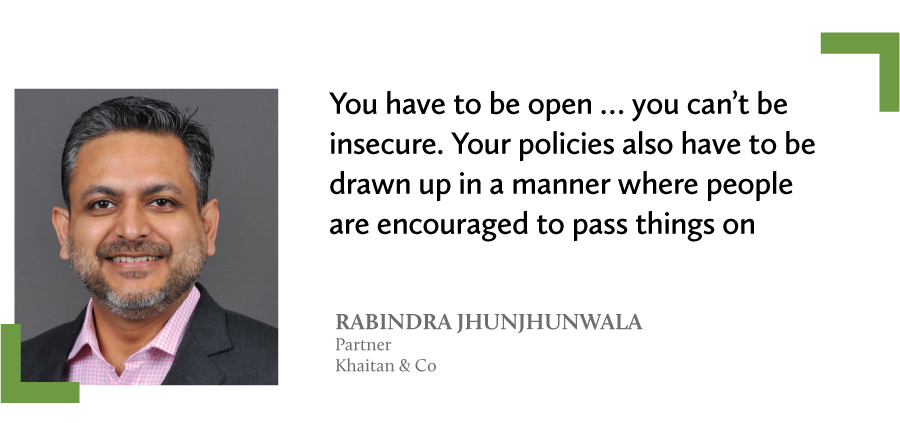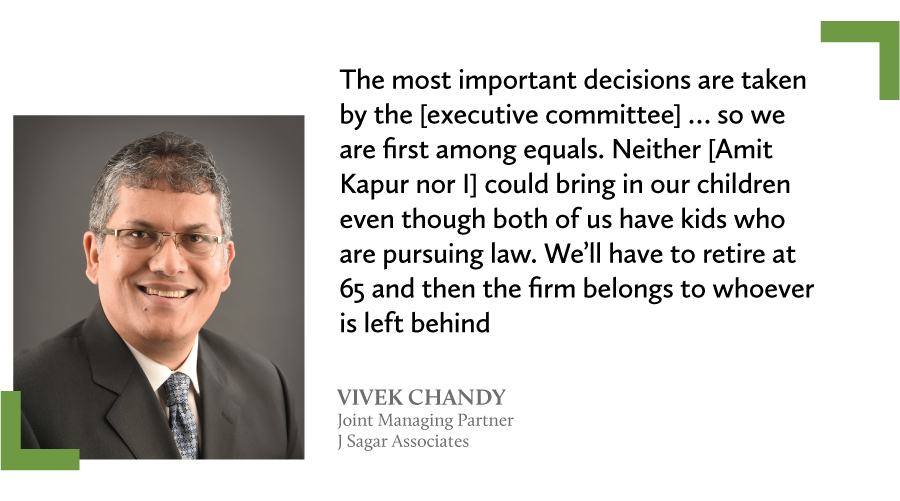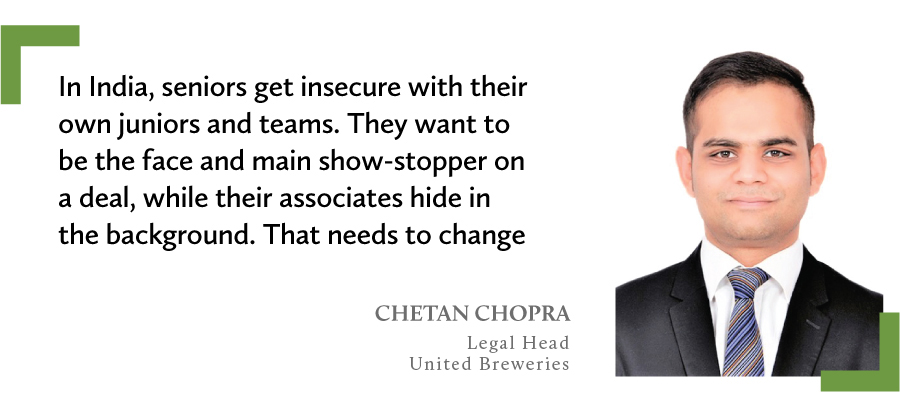What will happen to India’s iconic law firms when the time comes for their well-known promoter partners to bow out? Vandana Chatlani reports
India’s corporate law firms have invested much time and money on practice development, technology, branding, office premises, talent acquisition and training in an attempt to build institutions that are greater than the sum of their parts. While such forward thinking has brought about transformations on several fronts, some key areas have been slow to change.
One of these areas is the tendency for managing partners or promoter families to enjoy disproportionately high prominence when compared to that of their law firms as a whole. Iconic names such as Anand and Anand, AZB & Partners, Cyril Amarchand Mangaldas, J Sagar Associates, Khaitan & Co, L&L Partners, Shardul Amarchand Mangaldas & Co and more, which bring together the talents of hundreds of highly sought-after lawyers, remain stubbornly associated with one key individual or family in the minds of many clients. Ask a client or foreign lawyer to name their preferred Indian law firm and answers such as “the Shroffs”, “Pravin Anand” and “Zia” are given as often as the actual names of any law firms.
Having a celebrity managing partner may well be an advantage for wooing clients and wielding influence, but it also poses a formidable challenge when it comes to succession planning. With many of the current generation of promoter managing partners now in their 60s or older, what will happen to their law firms when the time comes for them to bow out?
“We have to recognize that Indian law firms, unlike their Western counterparts, do not have decades of experience with succession planning,” says Mukesh Butani, the founder of BMR Legal. “Of course, India has Anglo-origin firms, primarily in Mumbai and Kolkata, like Crawford Bayley & Co and Mulla & Mulla, and Indian firms such as Khaitan & Co, or maybe the combined Amarchand, which have experienced several generations of leadership. However they are probably exceptions.”
Of course, not all firms shy away from grooming the next rung of leaders. “Newer firms make succession a non-issue,” says Amitabh Lal Das, director and head of legal, compliance and regulatory at Max Life Insurance. “They may not talk about it directly, but they do other things to reassure clients that there will be no disruption.”
One leader renowned for stepping aside at the age of 65 was Jyoti Sagar, the founder of J Sagar Associates (JSA). In a legal market where lawyers work well into their 70s and even 80s, Sagar’s decision was unconventional and somewhat shocking to his peers and clients.
“Jyoti Sagar’s plan of retirement was unheard of,” says Chetan Chopra, a former JSA lawyer and current head of legal at United Breweries.
“Everyone wondered what was wrong with him. Jyoti’s own uncle, Vidya Sagar [the founder of Remfry & Sagar] worked into his 80s. Everyone was apprehensive of this decision, but they accepted that JSA was an institution, not an individual practice. Jyoti himself said that he didn’t want to be a 90-year-old lawyer, a shadow of himself, unable to deliver work like he used to do. He’d rather have JSA’s flag flying high with more competent younger partners. It was a very experimental thing at that time.”
JSA is one of the few firms in India that prohibits family members and spouses from practising at the firm. “Jyoti was a pioneer among Indian law firms,” says Das. “The rule that you cannot have children working at the same firm showed by design that there was a succession thinking.”
A lack of leaders?
While law firm breakaways and the departure of veteran partners indicate the problem with family-controlled firms, some argue that managing partners are unable to step aside because of a lack of true leadership options. “The biggest issue when I meet most of these managing partners and founders is that they are rarely able to find someone who acts like a leader,” says Bithika Anand (no relation to Pravin Anand) who is the founder of Legal League Consulting. “There are very few who can think like entrepreneurs, rather than employees, and take an organization forward.”
Butani is familiar with the challenges of succession, particularly with regard to appointing new leaders. Before setting up BMR Legal in 2010, he, along with fellow ex-Arthur Andersen partners Bobby Parikh and Rajeev Dimri, launched tax advisory firm BMR Advisors in 2004, following the demise of Arthur Andersen two years earlier.
“One of the real growth challenges we faced was how to move from the first-generation founders, who were the CEOs of the firm, to the second generation,” says Butani. “The governance structure supported by an advisory board clearly articulated that managing partners could not serve for more than two terms. After Bobby, I stepped in. In my second term, the firm’s advisory board couldn’t envision a clear leader to hold the partnership and take it to the next level. It wasn’t just about growth and profitability; it was about growing the firm’s franchise.”
BMR eventually divested its talent pool after striking a deal with two of the Big Four accounting firms. About 300 tax professionals including 21 partners joined Deloitte, while KPMG lapped up the remaining 100 professionals and another 12 partners from the M&A and risk advisory practice. Prior to those deals, a group of about 30 transaction lawyers moved to Shardul Amarchand Mangaldas & Co (SAM & Co).
Many firms within the legal community may suffer a similar vacuum of leadership, if and when their founders decide to step aside. “Are these firms developing leaders to substitute their iconic founder partners?” asks Butani. “I accept it’s not easy, but the large law firms have a task cut out for themselves on succession.”
Worthy heirs?
Several younger lawyers whose parents or family members are promoters or managing partners at law firms have already become embedded in those firms. These include lawyers such as Dhruv Anand (Anand and Anand), Badri Narayanan (Lakshmikumaran & Sridharan), Natashaa Shroff, Shweta Shroff Chopra and her husband Naval Chopra (SAM & Co), and Rishabh Shroff (Cyril Amarchand Mangaldas).
“When there are families and children involved, then the successor is the child – it’s a no-brainer,” says Bithika Anand. “I don’t see a firm where if they have children, they are thinking of succession through other ways.”

“I knew people who had been in the system for 30 years and still hadn’t become equity partners,” says Chopra, with reference to one family-controlled firm. “I asked them why, and they said they would have had to pay an extortionate amount to buy equity.”
“These are proprietary organizations, and no one wants to get rid of the power, influence and money that you can get by being in control,” says Vivek Chandy, joint managing partner at JSA, who moved to the firm 10 years ago. “That’s the idea behind not letting people go beyond a particular point.
“Previously, I was with one of the other tier-A law firms where I couldn’t have been anyone relevant even though I was a top performer. Today we’re seeing some good people join us knowing that based on hard work, determination and competence, you can go right up to the top. That’s really a driver.”
Some firms established by families, at least in name, have appointed non-family members in leadership positions, although their share of the firm’s equity is unknown. These include: Akshay Chudasama, the regional managing partner in Mumbai at SAM & Co; Anju Khanna, managing partner at Lall & Sethi; and Ashwin Julka, managing partner at Remfry & Sagar.
Remfry & Sagar was established in 1827 by Henry Oliver Remfry, a solicitor who sailed to Kolkata from Cornwall. Vidya Sagar, a successful barrister and solicitor who headed Sagar & Company, was invited by the Remfry family to acquire the practice in 1973. The two firms combined in 1990 and became known as Remfry & Sagar.
When Sagar passed away in 2011, his role was not passed on to his children as they had chosen different career paths. Hemant Sagar launched a successful career in the fashion industry, designing clothing for celebrities and the aristocracy under the couture label Lecoanet Hemant, which he established in Paris with partner Didier Lecoanet. Now back in India, the duo have designed pret collections, explored sustainable fashion projects, and created Ayurganics, a line of organic eco-friendly clothing infused with the essence of plants. Vidya’s daughter, Rosemary Sagar, is a finance specialist and chief investment officer at the Kingdon Foundation in New York, where she manages investments in hedge funds, private equity funds, late-stage venture capital funds and more. Although Rosemary does not practise law, she is a member of the executive committee at Remfry & Sagar.
A similar situation exists at AZB & Partners, where the children of founders Ajay Bahl, Zia Mody and Bahram Vakil have chosen different career paths and are uninterested in taking on the mantle from their parents.
As such, Bahl, Mody and Vakil have started the process of succession planning, having identified key senior partners in Mumbai and Delhi to assume a greater management, client relationship and mentoring role. This management committee comprises Sai Bharatan, Rajendra Barot, Darshika Kothari and Ashwath Rau in Mumbai, and Hardeep Sachdeva, Vinati Kastia, Anil Kasturi and Gautam Saha in Delhi. The teams have been in place for more than two years and “it’s proving to be good for us,” says Mody, although she admits it is “a slow process because the weight of the founders has grown over the years”.
Second in command
Mody says that the management committee in time will become the “go-to” for clients, with the founders seen as “a safety net”.
Mody, Bahl and Vakil want to ensure the next rung can hold important clients, develop a market standing that earns them respect within and outside the firm, and provide a sense of leadership to younger partners. “We push them wherever we can by introducing them to law firms, key clients and new clients, taking them along with us on business development trips and encouraging them to do those trips on their own,” says Mody.
In terms of external training AZB has had support for the past two years from Chris Saul, a former senior partner at Slaughter and May. “He visits us every two months and does a lot of workshops with everybody; with me, Ajay, Bahram, with our management committee, with the senior and junior partners, and with partners-to-be,” says Mody.
At Khaitan & Co, succession planning is also on the agenda. One way this is achieved is through the presence of at least two partners on key client relationships or initiatives, and the willingness to bring junior partners in. “You have to be open … you can’t be insecure,” says partner Rabindra Jhunjhunwala. “Your policies also have to be drawn up in a manner where people are encouraged to pass things on.”

At JSA, equity is tangible and calculated using a number of criteria. “Unlike at other firms, where the cream is lapped up by a few people, here it’s really going to all the partners in an equitable manner, based on certain agreed principles such as the work you bring in and a small component for how long you’ve been at the firm,” says Chandy. “If a particular practice area does well, all those in that practice area also get extra points. It’s a very complicated formula, but it’s absolutely transparent and arrived at by the whole partnership. It’s something we keep modifying from time to time to make it better because there’s always room for improvement.”
JSA provides internal and external training programmes to develop the next generation of leaders. Last month, UK-based Lexington Consultants conducted sessions for salaried partners at JSA on the qualities necessary to hold equity. “The idea is to help all the competent people to realize their potential because not every salaried partner will become an equity partner,” says Chandy.
Designing a handover
The form and outcome of a succession plan depends on factors including the size of a firm, its work ethic and culture, the willingness of founders to hand over the reins, compensation structures, and attitudes towards mentoring.
Any form of succession at firms that operate an “eat what you kill” approach may be challenging because of a structure that rewards operating in silos and keeping work to oneself. The idea of individual performance taking priority over sharing limits collaboration and reduces the creation of cohesive multidisciplinary practices. It also means individuals take precedence over teams, stifling the growth of a firm and potentially affecting client continuity.
The handling of private client work may also have a bearing on succession planning. “That is one area in which many lawyers would keep their cards close to their chest because, by working directly with promoters, you could win many more assignments,” says Jhunjhunwala. “At Khaitan, it’s not just Haigreve [Khaitan], but many other partners who routinely do private client work. We also have multiple partners in every practice area. That is also succession planning – you mitigate the risk of unexpected practice area closure, or even law firm closure in the case of a smaller firm, if a partner leaves.”
Sophisticated clients are alive to the risks of consulting only one or two partners. Several spread their work across law firms, carefully cherry-picking the best lawyer for each matter. “I have discerning clients who tell me exactly which senior and junior partner they want on their teams,” says Mody. “People are already seeing who they want in different domains, geographies and for different types of asset classes. They expect us to provide them with choices, with broader bench strengths, rather than getting locked into just one or two partners, especially if they are large clients.”
 Seamless transitions
Seamless transitions
For a smooth transition to occur, outgoing leaders should consider performing a critical analysis of success factors and outline areas of improvement for potential candidates, keeping in mind the larger strategy of the firm, according to Butani. “You don’t want a leader to simply emulate all the qualities you have,” he says.
An outgoing leader should also ensure that their successor is able to preserve and uphold the core values and ethos of the organization without stepping on toes. “The transitioning leader has to recognize that he or she is no longer a leader, but merely a mentor,” says Butani. “This change of status requires a different mindset, which many Indian leaders, not just in the legal community, find difficult to accept, or are just unwilling to accept.”
Some, however, have made that leap. Jhunjhunwala says partners have a retirement age at Khaitan & Co, and that retirement is tied to the firm’s compensation structure. “We readjust our equity percentage every year and partners always retire with less than what they had at their prime,” says Jhunjhunwala. “That’s planning for the next generation. If you know you’re close to retirement, you start offloading things to people. Whether you like it or not, at Khaitan you have to do it.”
 Millennials and managing partners
Millennials and managing partners
The challenges of succession for current leaders go far beyond delegating power, sharing equity and reassuring clients. Managing partners planning for the future must also deal with the unique aspirations of the millennial generation.
“The millennial desire is not for job security; it is all about experiences,” observes Butani.
“When I see someone 20 years younger, I notice that there’s a vast difference in their whole approach to doing things,” adds Jhunjhunwala. “That is the millennial style of functioning. Many may decide they don’t want to be partners, or even lawyers for that matter. One may also start looking at non-lawyers, professional managers or executives taking on management responsibilities. We will have to keep evolving. The idea of succession planning may look very different in 10 years’ time.”
Speaking of BMR Legal’s future, Butani says the firm may grow from 15 lawyers and two partners to perhaps 35 lawyers and four partners in the next few years. He hopes to develop younger partners to take over, but has nothing planned on how a transition will work. “It may be that I reduce my workload in the next five to seven years and one of the younger, more dynamic partners gradually takes over,” he says. “I hope I have a choice of two or three people … right now I don’t.”
Chandy and Amit Kapur hold their positions as joint managing partners at JSA until March 2022. The managing partners are selected by the entire partnership from an executive committee (excom) consisting of five senior partners. The managing partners serve for three years until a new excom is elected by the partnership.
“The most important decisions are taken by the excom and a majority on the excom, so we are first among equals,” says Chandy. “Neither of us could bring in our children, even though both of us have kids who are pursuing law. We’ll have to retire at 65 and then the firm belongs to whoever is left behind.”

For now, cutthroat competition within India’s legal circles means law firms must step up their game, propelling their teams, regardless of seniority, with the skills, knowledge and experience to win client approval.
“In India, seniors get insecure with their own juniors and teams,” says Chopra. “They want to be the face and main showstopper on a deal, while their associates hide in the background. They don’t want juniors in meetings or on calls. That needs to change. In broader HR parlance, they ask, ‘What is the difference between a leader and a boss?’
“A boss tries to keep shining, while a leader grows his pupils.”
What clients want
Succession isn’t a top priority but it does increase a firm’s attractiveness, say in-house counsel
In-house counsel are candid: Succession planning is not considered when choosing a law firm. This does not diminish the importance of such planning in their minds, but for the purposes of legal work, many other factors come first.
Amitabh Lal Das, director and head of legal, compliance and regulatory at Max Life Insurance, explains that his criteria vary widely. Before engaging a firm, he judges its expertise, quality, responsiveness, accessibility, size (for specific transactions), the comfort of the company’s stakeholders, billing rates, previous interviews, references and more.
“At some of the other companies I have worked for, we have considered whether law firms treat their associates well, but I haven’t taken into account this factor of succession, nor have I seen others do it,” says Das.
Chetan Chopra, legal head at United Breweries, echoes this view, saying that he chooses law firms based on their expertise in a specific area, and the nature of an assignment. Recently, he has gone as far as to request particular associates to work on his matters. “When you have worked with different teams, across spheres, and you’ve got results, you don’t want to break the winning streak,” explains Chopra.
“You may end up engaging the same counsel. You may also want the same juniors at times, even though that is usually up to the partners. These juniors will be the ones drawing up the first draft of a contract or petition. You don’t want to burn the midnight oil on a draft. So assigning work to juniors who have proved their capability helps save us energy and billing hours.”
This spread of work and an astute eye for the right legal talent means many larger companies will often engage the services of multiple law firms, thereby making succession a relatively unimportant issue. “While we build relationships, engagements are per assignment, and we tend to avoid exclusive engagements or engagements in perpetuity,” says Das. “We haven’t found ourselves in a situation where succession planning, or the lack of it … will adversely impact us in a material way.”
While succession planning does not form part of the selection criteria for many clients, it remains an important consideration for ensuring business continuity. This is particularly relevant for firms that have developed a longstanding relationship with certain clients and a deep understanding of their business over a period of time.
“At its most serious, a lack of succession planning could carry the risk of a disruption to the provision of legal advice, with the inherent inconvenience of re-inventing the wheel with other firms, which would naturally take some time to develop the same understanding of our needs,” says Priya Mehra, the general counsel at IndiGo Airlines.
Corporate counsel consistently look for the most promising option in the market, and current competition means extensive choices. And while no firm is indispensable, law firms must also contend with clients who are so accustomed to dealing with the current leaders that they are unwilling to work with the next rung.
“I don’t necessarily try and push clients into a situation where they cannot reach me,” says Zia Mody, managing partner at AZB & Partners. “Whenever clients require me, or there’s a fire that needs to be fought and they need a little bit of comfort and soul searching, Ajay [Bahl], Bahram [Vakil] and I are available. Clients work with our senior and junior partners, allowing them to build more confidence and lasting relationships with our second rank. That pyramid works well because the client doesn’t feel that by working with one or more of my seniors, I’m ousted, so to speak.”
Having a strong second rung and progressively developing clients’ trust in them is paramount to smooth transitions of power. “I’ve seen both sides of the coin,” says Chopra. “In order to grow, you need to develop the second line because you can’t be doing everything on your own. It takes time for a client to trust a new face, even if they trust the main partner.”
Many large companies have drawn up detailed plans and policies for business continuity including handovers of key personnel. “At Max Life, we are focused on succession at every level,” says Das.
The company holds an organization talent review each year, led by HR working closely with managers and leaders of all departments. The review assesses the strength of organizational talent against a list of competencies identified by the company for organizational growth and the upholding of company values. The review is also a way to keep the company future ready and ahead of the curve.
“Succession planning for roles is a core component of this exercise and has now become embedded in our culture,” says Das.
While ensuring continuity from a business and legal perspective is crucial, law firms should be mindful of other elements, such as diversity scores, which could determine their selection in the future. “A lot of general counsel in the US and UK are choosing law firms based on how positively oriented they are in diversity and inclusion [D&I],” says Das, who has been tasked to look into D&I for the entire organization. “It’s fairly new, but maybe in the future even general counsel in India will make D&I and other softer issues a priority when hiring outside counsel.”





 Seamless transitions
Seamless transitions Millennials and
Millennials and 























